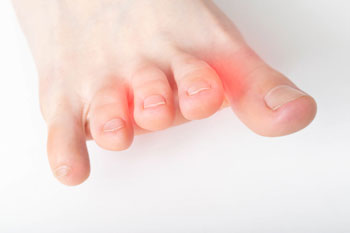
Morton’s Neuroma, also known as inter-metatarsal neuroma, is a thickening of tissue around the nerve that runs between the third and fourth toes.
The thickening of nerve tissue is the body’s response to the nerve being compressed or irritated. This irritation is often caused by wearing high heeled shoes that force toes into the toe box or other pointy footwear that squeeze the toes together.
Flat feet, bunions, and hammertoes can also contribute to the formation of Morton’s neuroma as well as injuries and participating in physical activities which repeatedly stress the ball of the foot, like court sports or running.
Symptoms of Morton’s Neuroma
Morton’s neuroma is a progressive condition. At first, symptoms may come and go, only occurring during activity or when wearing certain shoes. As time goes on and the neuroma gets bigger, the symptoms will worsen.
Because of the location of the nerve that is affected in Morton’s Neuroma, symptoms are typically felt in the ball of the foot:
- Pain
- Tingling
- Numbness
- Burning
- The sensation that a sock is bunched up in the front of the shoe
- The feeling of having a pebble stuck in your shoe
Diagnosing and Treating Morton’s Neuroma
To make a diagnosis of Morton’s neuroma, your podiatrist will need to perform a physical examination, run various tests, and may need to evaluate diagnostic imaging.
There are both conservative and surgical treatments for Morton’s neuroma. An early detection of this condition increases the chance that it can be treated conservatively.
Conservative (non-surgical) treatments include:
Icing the affected area
Wearing custom orthotics and padding to lessen compression and pressure on the nerve
Taking nonsteroidal anti-inflammatory medications to reduce inflammation and pain
Making modifications to footwear to allow for more room in the toe box
Getting cortisone or other types of injections to reduce inflammation and pain
Surgical treatment. If the condition does not respond properly to more conservative treatments, your podiatrist may recommend surgery to remove the nerve and release ligaments that are tight in the surround area.
Morton’s neuroma is not only uncomfortable, but if left untreated, may lead to permanent damage. Call a podiatrist as soon as possible if you have any of the symptoms listed here.
